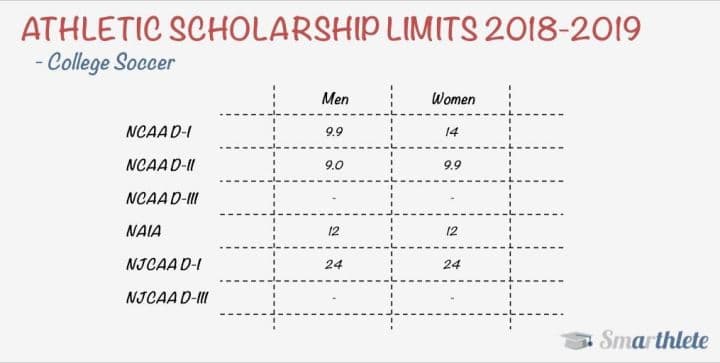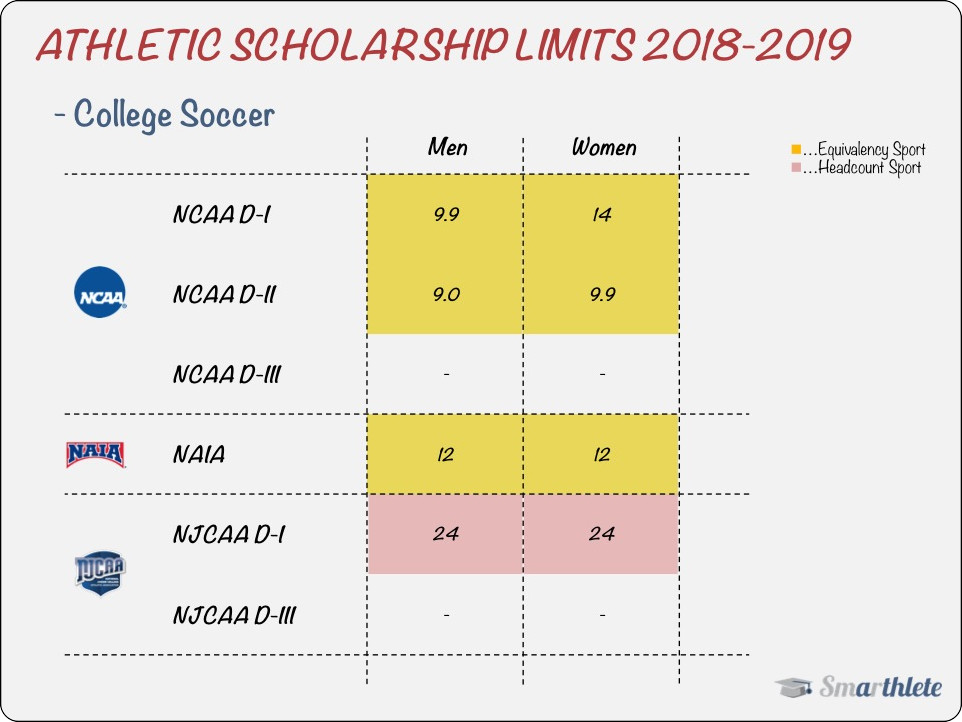Number of Scholarships in College Soccer

The 2018 FIFA World Cup has just been kicked off, giving a global audience across the world exciting weeks to look forward to.
Yes, soccer is the most global sport in the world and consequently, a sport that is available for intercollegiate competition in the US as well.
But that's not the topic of today's edition of the Friday Scholarship Guide - the topic actually is the kind of scholarship money that is available out there for athletes with a certain level on the pitch. Let's look into that in more detail by going through the various divisions, sponsoring college soccer.
Types of Scholarships
First off, and that's really important to keep in mind: not all divisions, sponsoring college soccer, offer athletic scholarships. That doesn't mean it's not an attractive place to go study, compete and graduate. Many schools offer attractive academic scholarships the amount of which can end up being way more than what another school would offer in athletic money.
The 6 large divisions are the following:
- NCAA D1
- NCAA D2
- NCAA D3
- NAIA
- NJCAA D1
- NJCAA D3
Note that NCAA D3 schools and NJCAA D3 schools don't have sports scholarships available!
Soccer is an equivalency sport on the NCAA and NAIA level. This means that coaches may distribute their available scholarship budget to as many players as they like. On the NJCAA level, soccer is a headcount sport with regards to scholarship limits. That means coaches can't give a player, say, a half scholarship, the remaining half of which could then be used for another player.
Scholarship Limits in College Soccer
The above divisions set standards with regards to how much scholarship money may be distributed to the various players. It is important to keep in mind that these scholarship limits are based on the assumption that a soccer program is fully-funded, making available the maximum amount of scholarship budget allowed. That is not always the case, which is why some programs will have a harder time attracting strong(er) athletes than others:

- NCAA D1 men's soccer allows a limit of 9.9 scholarships per team.
- NCAA D1 women's soccer allows a limit of 14 scholarships per team.
- NCAA D2 men's soccer allows a limit of 9.0 scholarships per team.
- NCAA D2 women's soccer allows a limit of 9.9 scholarships per team.
- NAIA allows a limit of 12 scholarships per team, both in men's and women's soccer.
- NJCAA D1 recently increased the cap from18 to 24 scholarships per team.
It's important to know that your grades in school (GPA) and test results on SAT and or ACT tests could entitle you to additional academic grants. Read up on that by checking out "2 Academic Focus Areas For Recruits to Boost Their Chances". It says "college tennis" in the article. Just ignore that - there really is no difference :)
Value of Athletic Scholarships
What's the value of a scholarship and what does it cover?
The scholarship covers a number of different costs, although the definition differs somewhat between the various governing associations.
- According to NCAA rules, a full scholarship covers "tuition & fees, room & board and course-related books".
- According to NAIA rules, a full scholarship covers tuition, mandatory fees, books & supplies required for courses in which the student-athlete is enrolled, and room & board.
- According to NJCAA rules, a full scholarship covers tuition & fees, room & board and course-related books (+ up to 250 USD of course material of & one-time transportation to and from the college per academic year).
Simply put, if you are the recipient of a full scholarship in soccer, your total costs of attendance are covered by the school. But don't get all too excited about the idea of getting a full-ride. This is very uncommon, as only a very small percentage of athletes receives such a large scholarship offer: "The Truth About Athletic Scholarships at College"
Case Examples of Soccer Scholarships
Now let's put all the pieces together to give you a better feel for the dynamics of the scholarship search:
Example 1: Say you are a female player (Player A) having had good conversations with a number of coaches from NCAA D-I, NCAA D-II and NAIA schools.
- Coach A from a fully-funded D-I school offers a full-ride to you. That leaves the coach with another 13 scholarships to distribute among her players.
- Coach B from a D-II school really wants you on the team and makes you a great offer, covering ~90% of all the costs. The team is not fully-funded and only has 7 scholarships instead of the permissible 9.9 available. If you accepted the offer, that would leave the coaching staff with 6.1 scholarships for the rest of the team.
- Coach C from a NAIA team (fully-funded) doesn't have much money left, because only 2 players graduate the year you would start enrolling. He can offer you a third of a scholarship and the school costs 30,000 USD/year. This leaves you with 20,000 USD to pay for Year 1 and the coach has the rest of his scholarship money (12 - 0.33 = 11.66 scholarships) tied up among other athletes on the team. He emphasizes however that you can expect a significant raise in Year 2, as the team will be losing 8 players and significant scholarship money becomes available then.
Example 2: Let's assume you are a male player (Player B) who has had great results in the past, but little financial support from his family. A relatively large scholarship is needed.
- Coach A from a NJCAA D-I school sees the impact you could have on the team and offers a 100% scholarship. The coach is then left with another 23 scholarships. As NJCAA schools are 2-year universities (community colleges), you could take the offer, develop for 2 years and then transfer to a 4-year university to finish you degree.
- Coach B from a NCAA D-2 school wants to recruit you as well and offers a 60% scholarship. Your initial response is negative, as it seems like fairly little compared to the offer from Coach A. But considering a full year at the school only costs 25,000 USD, your family would be OK with covering the remaining 40% of costs, amounting to 10,000 USD (25,000 USD x 0.4). Not the easiest call to make and your decision will require you look into everything: school, team, your chemistry with the coach, etc.
Key Things to Know About College Soccer
Here are a few things to keep in mind:
- In-state, out-of state & international students
There is an important difference depending on where you come from. Schools' tuition fees differ for US students (whether they study at a college within their state of residency or in another state) and international students. The cheapest option is enrolment at college in the state of residency (in-state). - Duration of agreement
While scholarships are only awarded for one academic year, scholarship agreements are typically extended year after year and cover the full four years of the students' enrolment. It's not unusual that you can "earn" more scholarship money if you perform well on the team. - Scholarship availability
Keep in mind that a college soccer team consists of a very large number of players, easily exceeding 30; typically a good mix of freshmen, sophomore, juniors, or seniors. As a result, there is only so much scholarship money available for the upcoming semesters, depending on the balance of the team. Say for example, there is not a single senior on the team - chances are low the coach will be interested, as she won't have a whole lot of athletic scholarship budget left. A team with 6-8 seniors? Lovely, there might be a nice amount of scholarship money available as the coach needs to replace his graduates!
Hopefully, this article has given you a great kickstart to really get going with your recruiting process.
Look no further, you will find all you need on Smarthlete. Sign up with a free recruiting profile, get discovered by coaches of all divisions and find a scholarship to play college soccer!
Or if you prefer to have somebody support you through the entire recruiting process, complete our Evaluation Form and let's talk about how we can get you recruited to your dream school! :)